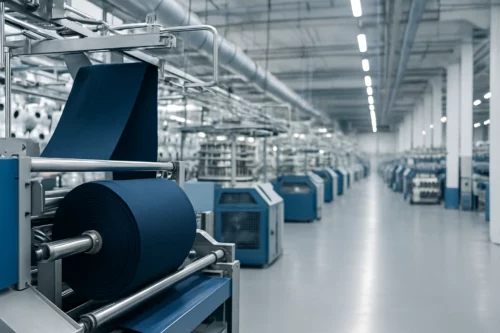bluesign Standards: Reducing Bisphenol Risks in Sustainable Textile Production

What is the concern about bisphenols?

Health impact:
Bisphenol A (BPA) is well known as an endocrine disruptor – can mimic human estrogen and therefore may affect fertility and disrupt the development of unborn child. In addition, BPA is also linked to several adverse health outcomes including cardiovascular diseases, hormone related cancer risk, obesity, and metabolic diseases.
Environmental impact:
Bisphenols leaching into water supplies and soil may lead to long-term ecological damage. Aquatic life, in particular, is at risk as bisphenols can disrupt the hormonal balance of fish and other organisms.

Moreover, Bisphenol A is classified in the EU as a substance that:
• causes toxic effects on our ability to reproduce
• causes serious eye damage
• may cause respiratory irritation
• may cause skin allergies
• very toxic to aquatic life
• very toxic to aquatic life with long lasting effect
Did you know?
Bisphenol A has been detected in the urine of 92% of adult research participants covering 11 European countries in the concentration exceeding safe level.
Are there any legal restrictions on bisphenols?
Bisphenols, especially BPA, are subject to various legal restrictions and regulations worldwide due to their potential health risks. Here’s an overview of some key regulations and legal lists where bisphenols are restricted:
European Union
• The candidate list of substances of very high concern contains three bisphenols
• EU restriction proposal for bisphenols of similar concern (BOSC) with proposed limit 10 ppm for sum
• Currently covered BP A,B,S,F,AF
• REACH BPA restriction
• Its use in the thermal paper has been restricted since January 2020
• BPA has been banned in infant feeding bottles since 2011 and in plastic bottles and packaging containing food for babies and children since 2018
United States
• The Food and Drug Administration (FDA) restricts the use of BPA in baby bottles, sippy cups, and the packaging of infant formula
• Since 2015 BPA is listed in the California Proposition 65 as substance causing reproductive toxicity
• California prohibits children´s feeding/ sucking/ teething products containing bisphenols
• Listed on TSCA Inventory by Environmental Protection Agency (EPA) – regulating and monitoring chemicals in control to human health and environment
Canada
• BPA is identified as toxic substance under the Canadian Environmental Protection Act, 1999
• Regulations under the Canada Consumer Product Safety Act prohibit the manufacture, advertisement, sale or import of baby bottles containing BPA
• BPA is listed on Canadian Cosmetic Ingredient Hotlist as a prohibited substance for use in Cosmetics
China
• In 2011 the Ministry of Health announced the prohibition of manufacturing, import and sale of infant feeding bottles containing BPA
Where can be bisphenols be found in the textile industry?
Although the primary route of exposure to bisphenols is through diet, as these chemicals can leach from food packaging, it is important to be cautious about other potential contact pathways. Bisphenols can also enter the body through the skin by contact with items like textiles that may contain traces of these chemicals. Therefore, it is crucial to pay attention to the materials we come into contact within our daily lives to minimize overall bisphenol exposure.
 Polymers Production
Polymers ProductionBPA may be used to produce a number of polymers including polyester, the most common synthetic fiber used in clothing and home textiles.
 Dye-fixing Agent
Dye-fixing AgentBisphenols may be used in dye-fixing agents to provide long-lasting colors.
 Adhesives and Binders
Adhesives and BindersBisphenols are used in adhesives and binders helping to assemble multi-layered products.
 Textile Coatings
Textile CoatingsBisphenols make coatings that provide durability and resistance, used in items like raincoats, upholstery, and outdoor gear.
Moving forward with bluesign!
Given the significant health and environmental risks associated with bisphenols, reducing, or eliminating their use is crucial. Protecting human health, especially vulnerable populations such as pregnant women and children, is a primary concern.
Bisphenols A, AF, B, F, and S, which are all currently listed by BOSC, are regulated under the bluesign® BSSL and BSBL. bluesign enforces a usage ban on BPA with one of the most stringent limits on the market, verifying compliance with most regulatory restrictions.
BPA from Chemicals and Consumer Safety
The use of bluesign® APPROVED chemical products guarantees BPA input at a very low level, based on the strict BSBL limit. Additionally, using bluesign® APPROVED materials and adhering to the Restricted Substances List (RSL) for sourcing ensures compliance with the highest market standards. Together with effective Input Stream Management (ISM) is the best strategy to ensure safety.
Textile recycling with bluesign
Textile recycling is a significant aspect of sustainability, but it often involves the unknown chemical mixtures including bisphenols.
This topic underlines the importance of the Input Stream Management. In general, reliable sources in combination with ISM and testing provide remarkable reduction of the potential exposure.
For bluesign® SYSTEM PARTNERS instruction regarding the use of recycled material is available in our guidance documents.
Alternatives? Use bluesign® FINDER
The push towards eliminating bisphenols in the textile industry involves finding safer alternatives that do not compromise the quality and functionality of the products. Research and development are focusing on biodegradable and non-toxic compounds that can replace bisphenols in various textile applications.
bluesign® FINDER offers the world’s most comprehensive positive list for APPROVED chemical products, all complying with strict bisphenol limits. It provides access to over 25,000 chemical products that support sustainable chemistry and clean production achieving the RSL compliance. Moreover, bluesign® FINDER offers nearly 200 bisphenol-free alternatives for aftertreatment agents.
With bluesign® certified textiles, consumers can confidently choose products ensuring safety and sustainability in every thread.


